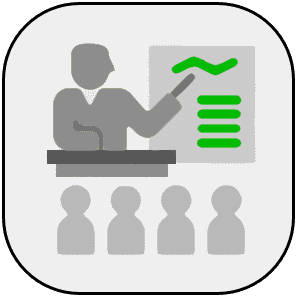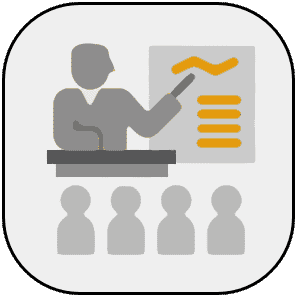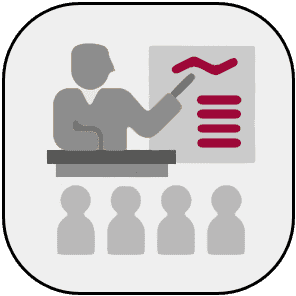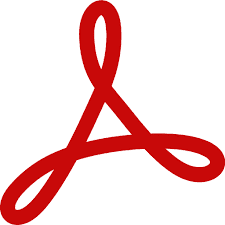What is the Leadership Pipeline?

Sometimes hiring an executive from the outside can be the only available
short term option. However Drotter, Noel and Charan argue that for
the long term, management should build, develop and maintain a pipeline of
skilled, prepared leaders from within the firm. Their Leadership Pipeline
model helps to create such a funnel of future management talent by explaining
what changes in time application, skills and work values are essential for
making the transition from one leadership stage to the next. Also their model
helps to understand the different demands of various management levels.
Origin of the Leadership Pipeline. History
The Leadership Pipeline idea was based on work originally done
at General Electric in the 1970s by Walt Mahler, a HR consultant and
teacher. Mahler set out to identify all the changes that were required to
be successful at different leadership levels. He concluded that the most important
change involved work values: what one believes is important in the new job.
Mahler also developed the Crossroads Model, suggesting that there were
specific leadership crossroads in every organization, each with its own specific
requirements. Drotter was a student and later a friend of Mahler and refined
and adjusted the crossroads model into the leadership pipeline model. Executive
Development and Coaching Consultant James Noel and Top-level Succession Planning
Consultant and Professor Ram Charan also contributed later.
6 Passages in the Leadership Pipeline. Stages
- From Managing Self to Managing Others. People enter this stage
when they demonstrate they are skilled individual contributors and they
have the ability to collaborate with others.
-
Change in Time Application: These people must learn how to
reallocate their time so that not only their own assigned work is completed,
but also they help others perform effectively.
-
Change of Skills: Shift from doing work to getting work done
through others.
-
Change of Work Values: From valuing their individual work
to valuing managerial work.
- From Managing Others to Managing Managers.
-
Change in Time Application: In this phase, managers must
only manage. They need to divest themselves of individual tasks.
-
Change of Skills: The key skills they must master during
this transition include selecting people to turn passage 1, assigning
managerial and leadership work to them, measuring their progress as managers,
and Coaching them.
-
Change of Work Values: Learn to hold first-line managers
accountable for managerial work rather than technical work.
- From Managing Managers to Functional Manager.
-
Change in Time Application: Participating in business-team
meetings and working with other functional managers. Creating a functional
strategy that enables them to do something better than the competition.
Develop a sustainable
Competitive Advantage
within their function.
-
Change of Skills: Develop new Communication
Skills and being able to manage some areas that are unfamiliar. Learn
to consider other functional needs and concerns. Teamwork with other functional
managers and compete for resources based on business needs.
-
Change of Work Values: Adopt a broad, long-term perspective.
- From Functional Manager to Business Manager.
-
Change in Time Application: Allocating time to think is a
major requirement at this level: Managers need to stop doing something
every second of the day and reserve time to reflect and analyze.
-
Change of Skills: Business managers are responsible for the
bottom line. Rather than consider the feasibility of an activity, a business
manager must examine it from a short- and long-term profit perspective.
-
Change of Work Values: Value the success of their own business.
- From Business Manager to Group Manager.
-
Change in Time Application: From running their own business
to succeeding indirectly by managing and developing several businesses
and business managers.
-
Change of Skills: Be able to:
-
Evaluate strategy in order to allocate and deploy capital.
-
Develop business managers.
-
Develop and implement a
Portfolio Strategy.
-
Assess whether businesses have the right core capabilities
to win.
-
Change of Work Values: Derive satisfaction from the success
of other people’s businesses. Appreciate managing a portfolio of business.
- From Group Manager to Enterprise Manager.
-
Change in Time Application: Set direction and develop operating
mechanisms to know and drive quarter-by-quarter performance that is in
tune with longer term strategy. A subtle shift from strategic to visionary
thinking, and from an operating to a global perspective. Let go of the
pieces, and focus on the Whole. Assemble
a team of high-achieving, ambitious direct reports, knowing that some
of them want his job.
-
Change of Skills: Ability to manage a long list of external
constituencies proactively.
-
Change of Work Values: Learn to value
Trade-offs. Appreciate
managing one entity.
Strengths of the Leadership Pipeline. Benefits
- Helps to understand that management and leadership roles are
not the same on all levels of an organization, because of many differences
in optimal time application, skills and work values.
- Dynamic model. Facilitates individual performance improvement,
Coaching,
Mentoring, training and experience
assessments and planning.
- Facilitates succession planning, leadership development.
Helps to identify and prevent potential pipeline failures.
- Improves selection processes.
- Facilitates more objective promotion decisions.
- Helps HR to focus on specific skills, time application and work values,
rather than rely on generalized training and development programs.
- Diagnostic tool to identify and remedy mismatches between individuals’
capabilities and their leadership level.
- Timing. The pipeline provides a system for identifying when someone
is ready to move to the next leadership level.
- Efficiency. Little or no time is wasted on jobs that merely duplicate
skills.
Limitations of the Leadership Pipeline. Disadvantages
- Aimed at large organizations. Can however be used in medium-sized businesses
as well, by removing the group management level and understanding that the
business manager is also doing the work of the enterprise manager.
- It takes a long time and sustained commitment to implement the framework.
- As with any model, try to avoid a too mechanical implementation of the
concept. Think holistically and with complexity of people and organizations
in mind.
Book: Ram Charan, Stephen Drotter and James Noel - The Leadership
Pipeline - How to Build the Leadership-powered Company
|
Forum discussions about Succession Planning.

|
Great Leaders Develop Future Managers and Leaders
Beyond building mighty companies, great leaders groom their managers to become in turn future successful leaders. That is according to Sydney Finkelstein (2016), who argues that what sets great leader...
 8 |

|
Leadership or Management Pipeline?
This appears to be a very helpful model for understanding management roles and planning management development. However, it also seems to be something of a misnomer as there is a clear difference betw...
 4  2 comments |

|
Implementing the Pipeline
In implementing a Leadership Pipeline I found that line management is very slow in taking up the challenge. Is that common or am I imagining it?...
 2  5 comments |
|
|
|
Courses about Succession Planning.

Beginners Course
|

Advanced Course
|

Course for Experts
|
|
|
|
The best, top-rated topics about Succession Planning. Here you will find the most valuable ideas and practical suggestions.
|
🥇
|
CEO Succession
Companies need to have a succession plans in order to retain talents, to grow their business. But especially for the CEO. This is a most important issue; it is a going concern for the company.
The su...
 17  7 comments
|
|
🥈
|
Executive Assessments Using Simulations
The success of a company depends on its top managers and executives. Decisions regarding engagements, staffing and positioning in this domain have extensive consequences and strategic impact.
Busines...
 12
|

|
Potential Assessment
For an employee to move from one passage to another, both, performance and potential needs to be sceintifically evaluated. Any tips on evaluating the Potential ?...
 8  5 comments
|

|
Identify Competencies First
I find the leadership pipeline a useful model to identify the leadership and management competences required at the respective levels.
I am trying to identify firstly the overall leadership and manag...
 6  3 comments
|

|
How to Develop Leadership Competencies?
A lot of books and articles by various authors have been written about certain competencies being essential for effective leadership. Less is written about how organizations can actually develop these...
 5  3 comments
|
|
|
|
Advanced insights about Succession Planning. Here you will find professional advices by experts.

Consultancy Tips
|

Teaching Tips
|

Practical Implementation Tips
|
|
|

|
How to Develop a Talent Factory How to Implement a Leadership Pipeline, Best Practices
In an article "Make Your Company a Talent Factory" (HBR June 2007), Douglas A. Ready and Jay A. Conger make some useful ...
|

|
Myths on REACHING the top What Experiences, Qualifications and Characteristics are Needed to Reach the Top?
I'd like to contribute a summary of an article by HRM Professor Monika Hamori of Instituto de Empresa Business School. H...
|

|
Categeories of CEO's Leadership Styles, CEO Types
In their book "The Secrets of CEOs", Steve Tappin and Andrew Cave identified that top-quartile CEOs fall into five disti...
|

|
Developing your Leadership Pipeline Implemention Guidelines and Best Practices
In the HBR article "Developing your Leadership Pipeline Dec 2003" Jay A. Conger and Robert M. Fulmer considered 4 guidel...
|

|
Building an Organizational Coaching Capacity Developing an Organizational Coaching Capacity, Learning Organization, Developing Coaching as an Organizational Capacity
COACHING ON AN INDIVIDUAL LEVEL
In their book "Trillion Dollar Coach: Lessons for Managers", Google's Schmidt, Rosenber...
|

|
Mintzberg: 7 Myths on Management Management Development, Leadership Development, Managers versus Leaders, MBA
Prof. Henry Mintzberg refutes 7 myths on leadership and management:
ORCHESTRA CONDUCTOR: One myth about management is t...
|

|
Five Leadership Development Ideas Leadership Development, Management Development, Coaching, Mentoring
Although years of research and analysis by biographers, historians, and scholars have produced an enormous library of bo...
|

|
Identify and Develop Leadership Abilities Leadership Development, Management Development, Coaching, Mentoring
Covey's 4 Roles of Leadership® helps managers to identify and develop 4 important abilities of 'true' leaders:
Modeling...
|

|
Leadership Best Practices Leadership Development, Leadership Tips
- The best leaders always know how to involve others in making decisions: You will get a better range of ideas and they ...
|

|
Leadership Development Strategies How to Develop Succesful Leadership Development Programs
According to Robert M. Fulmer, Stephen A. Stumpf and Jared Bleak in the article “The Strategic Development of High Poten...
|

|
How to Develop your Own Leadership Philosophy Leadership/Management Development, Coaching, Mentoring
In an article “When should a leader be directive or empowering? How to develop your own situational theory of leadership...
|

|
Recognizing Distressed Managers in Leadership Pipeline Transition Coaching, Mentoring, Management Development, Leadership Development
Moving from one manager level/phase to the following is a difficult task. Freedman (2011) describes the typical response...
|

|
CSFs for 2nd Generation Succession Small Business Transfers
Often small businesses are transferred from one generation to another. This may continue for several generations. The pr...
|

|
Guiding High Potentials Leadership Development
According to Ram Charan in Harvard Management Update Jan 2008 Vol 13 #1, the most effective way to move a high potential...
|

|
Top-3 Pitfalls in Talent Management: Common Mistakes by Talent Managers Talent Management, Management Pipeline, Leadership Pipeline, Management Development, Management Succession Planning
In companies talent management failures are made at various levels, from strategic failures to process and management fa...
|
|
|
|
Various sources of information regarding Succession Planning. Here you will find powerpoints, videos, news, etc. to use in your own lectures and workshops.

|
5 Ways to Develop your Leadership Skills Career Management, Career Planning, Management Development, Talent Management, Succession Planning
Obviously we all know that the best way to continuously develop your leadership skills is through 12manage ☺. Lear...
|

|
Learning Agility and Enterprise Agility Organizational Agility
This presentation provides insights into the usage of organizational agility in your organization. The presentation incl...
|

|
Effective Change Leadership and Management: Principles, Frameworks and Tools Change Management, Change Leadership
Comprehensive presentation on leadership and management in a change context.
1. Introduction and Overview
2. What is t...
|

|
Talent, Career and Succession Management and Management Development Career Management, Career Planning, Management Development, Talent Management, Succession Planning
Presentation about talent/career management and development including a lot of schemes which clarify each particular sec...
|

|
Succession Planning in Family Businesses Management Succession Planning
Presentation that elaborates on the main steps in Succession Planning with a focus on Family Businesses, including the f...
|

|
CEO Succession Planning Succession Planning
Presentation about CEO Succession Planning thereby making a difference between compliance-based and operational successi...
|

|
How to Build a Global Organizational Capability? MNCs, Multinationals, Multinational Companies, Globalization, International Leadership Development, Cultural Intelligenc
A. How to build a global leadership group in which people can cope with the complexity of working globally?
1. Re...
|

|
From Traditonal to Advanced Talent Management Talent Management, Talent Planning, Talent Acquisition, Talent Retention, Talent Development, Career Planning, Successio
In-depth presentation about talent management. The following sections are included:
1. Talent Management and Globalizat...
|

|
Leading versus Managing Understanding the differences between Leading and managing
Dr. John Kotter gives his opinion on what are the key differences between leading and managing.
- Management is a set o...
|

|
Leadership Pipeline Diagram Succession Management
Download and edit this 12manage PowerPoint graphic for limited personal, educational and business use.
Republishing in ...
|
|
|
|
Useful tools regarding Succession Planning.

News
|

Videos
|

Presentations
|
| |

Books
|

Academic
|

More
|
|
|
|
Compare with the Leadership Pipeline: General Management |
Coaching
| Mentoring
| Cultural Dimensions |
Cultural Intelligence
| Contingency Theory
| Situational
Leadership |
Leadership Styles
| 4 Dimensions
of Relational Work |
Spiral Dynamics |
Seven Habits |
Seven Surprises
| Johari Window
| EPIC ADVISERS
| Level 5 Leadership
| Hagberg Model
of Personal Power
| Interim Management
Return to Management Hub: Change & Organization | Communication & Skills | Human Resources
| Leadership
More Management Methods, Models and Theory
|
|
|














